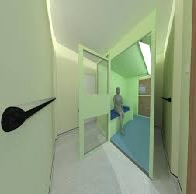Discussion on Seclusion in Mental Health Seclusion, restraint of mental health patients can fuel fears, ACT forum told
Locking a distressed person in a padded cell when they are hearing voices could be the worst possible treatment, a conference in Canberra has been told.

But the ACT is leading the nation in changing the culture of isolating mental health patients.
The practice of seclusion and restraint of mental health patients was put under the spotlight at a national forum hosted by the ACT at the Shine Dome.
The forum, which continues on Friday, was told powerful stories of the experiences of people suffering from mental health issues.
Discussion on Seclusion in Mental Health Advertisement
Deputy ACT chief police officer David Pryce said the account that crystallized the issue for him came from a man who sought help when hearing voices.
”He said: ‘Here I was, scared and not understanding what was happening to me because I had demons in my mind saying things. I was seeking help and I went to the hospital and they locked me in a room with myself and my demons – that’s the last place I wanted to be, alone, surrounded by these voices’,” Commander Pryce said.
Mental Health Commission chairman Professor Allan Fels told the conference he believed seclusion of mental health patients was a human rights issue.
The seclusion rate for children and adolescents was worrying, he said.
One view put to the commission was why the practice was still going on in a civilised country. ”The second view is that this is an OH and S issue and elimination is not realistic,” Professor Fels said.
It was generally agreed there was nothing therapeutic about the use of seclusion and restraint and that it added to someone’s trauma.
”The commission agrees that the safety of all concerned is paramount, but the endgame must be that seclusion and restraint is eliminated, particularly where children are involved,” Professor Fels said.
Information on seclusion in public mental health facilities was made available for the first time by the Australian Institute of Health and Welfare this week.
It showed seclusion rates were falling. The national rate of seclusion in 2011-12 was 10.6 events per 1000 bed days in public acute hospital services, down from 15.6 three years earlier.
ACT chief psychiatrist Dr. Peter Norrie said the territory now had a rate of 0.9 seclusion episodes per 1000 patient days. ”That’s the lowest in the country,” he said.
”We are clearly proud of our efforts in reducing seclusion and restraint. Seclusion is where someone who is significantly agitated or distressed is put in a room, locked in that room, the room has no stimulus and no risk of self-harm.
”If you are agitated and distressed and you are put in a locked room, you can be even more fearful of what’s going on. If another episode of illness comes along, in terms of trust we’re the last people that person would want to come to.”
Anne Tighe, an occupational therapist at the ACT adult mental health unit, said it was
important to identify the factors or triggers behind a patient’s frustration and behaviour
requirement
The discussion is to be supported with relevant and appropriate references. There are to be a minimum of ten references (including the article), at least two (2) being researched based journal articles. No Wikipedia and only two (2) web based sites
This assessment aims to enhance students learning related to contemporary mental health issues including reasoning, critical thinking, reflection and care planning. The essay will provide an opportunity for students to be analytical and synthesize information within the expectations of academic writing




